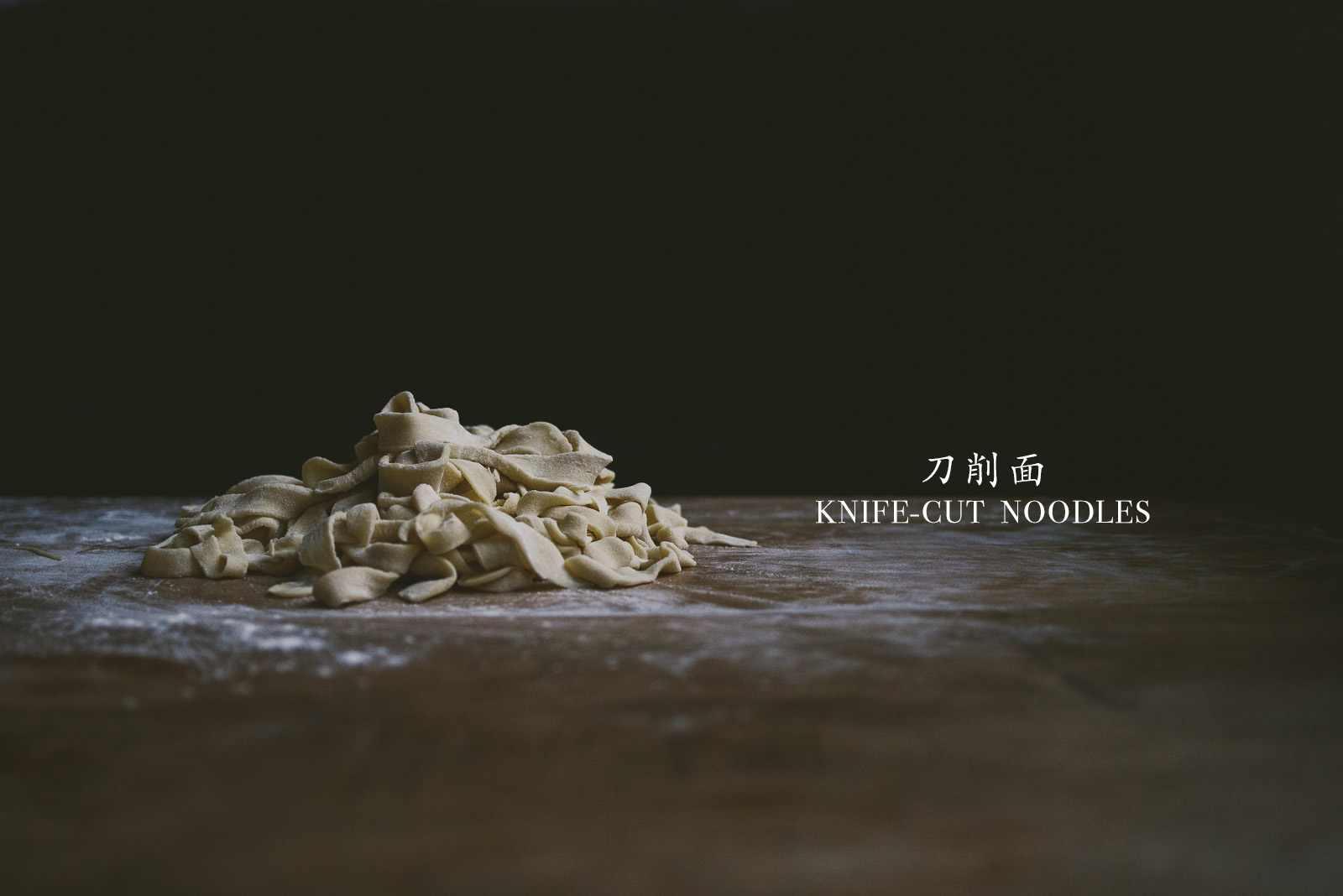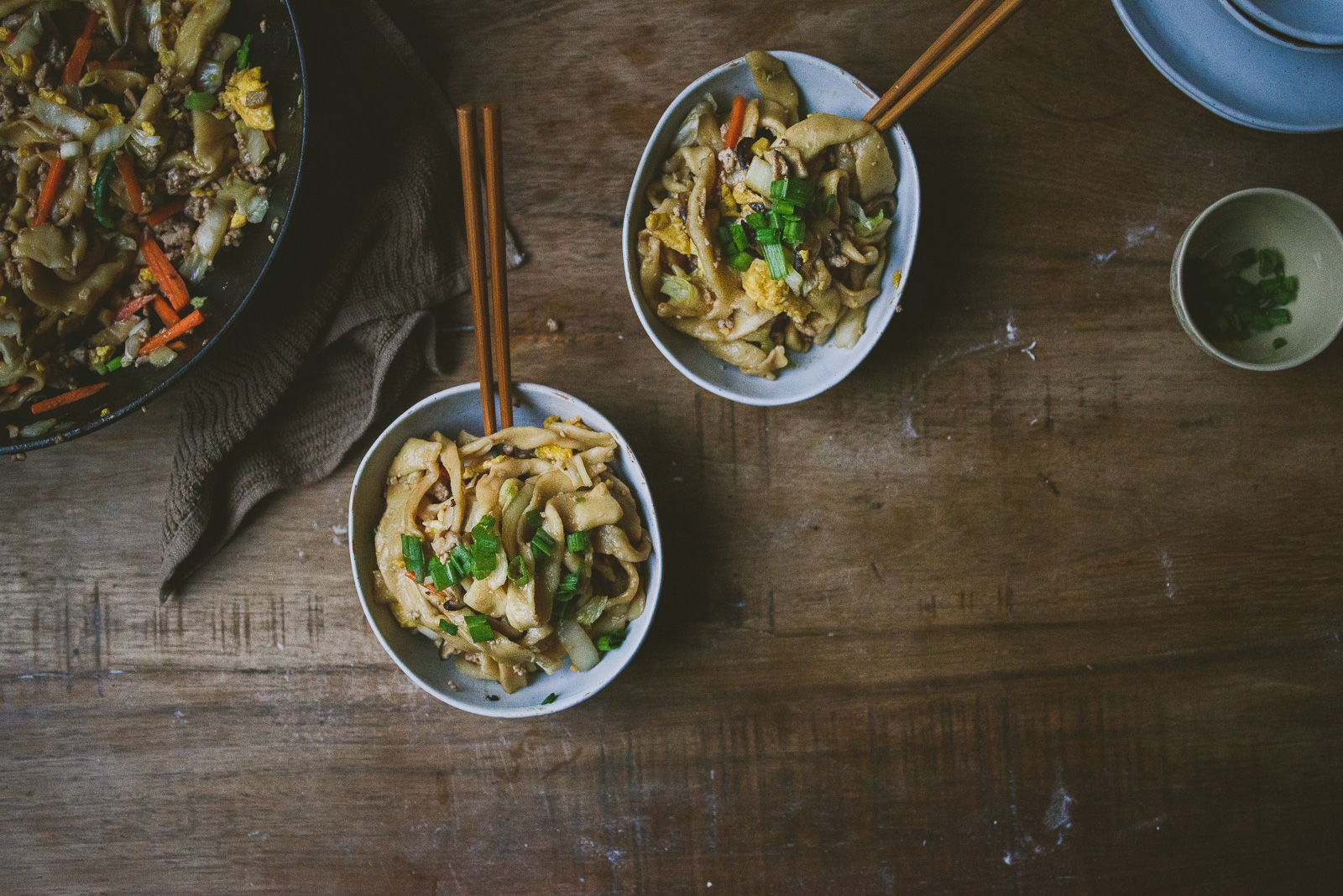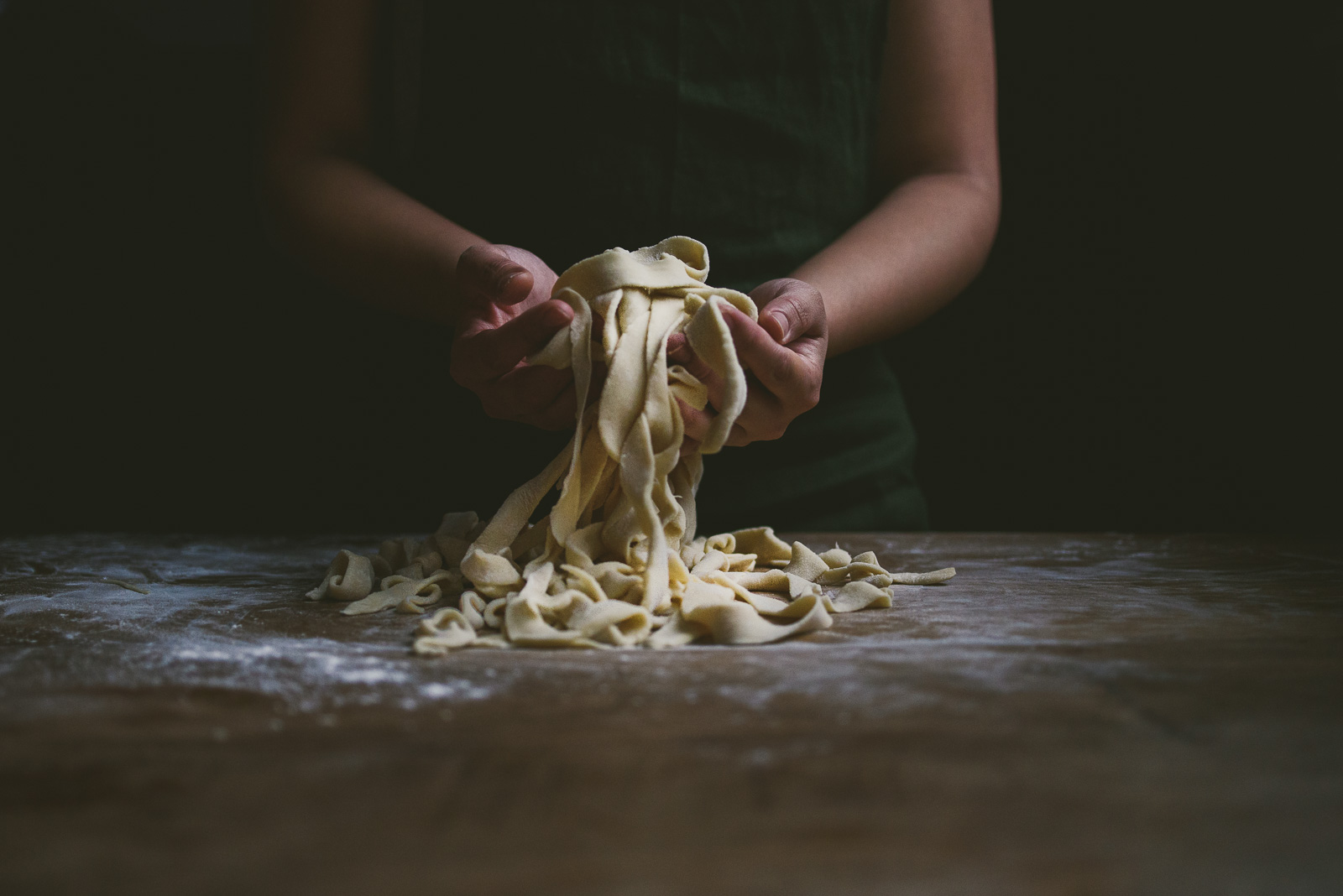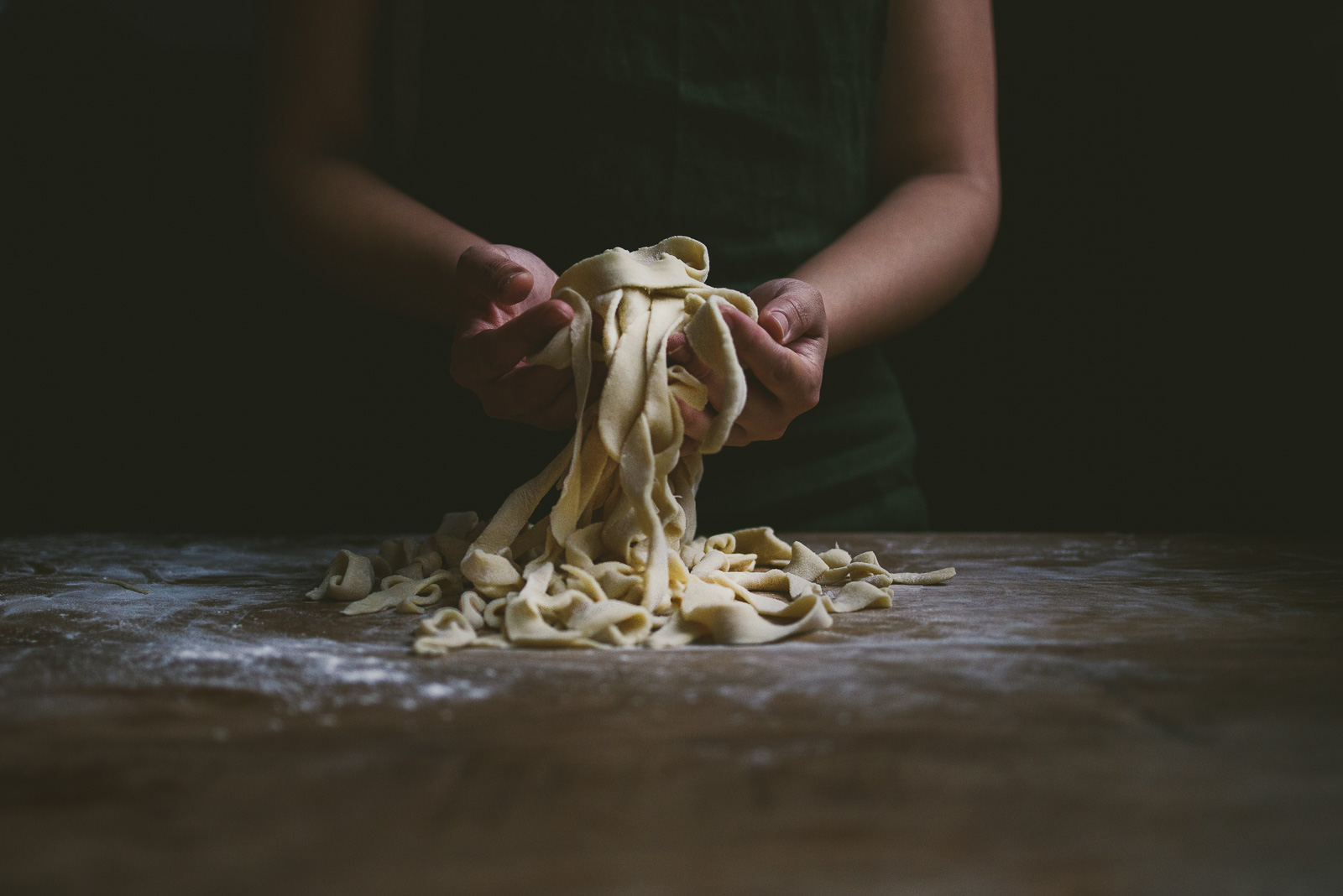刀削面 Dao Xiao Mian Knife Cut Noodles at Home

无面不欢 (wu mian bu huan) is a saying that can be loosely translated to no satisfaction without noodles. That’s pretty much me!!! The first time I had knife-cut noodles was in China; I was young, so my memory is spotty at best, but the texture and feel of these noodles stayed stubbornly in my mind. When I came back to the states, I always kept an eye out for knife-cut noodles. Luckily for me, we found a restaurant that serves these stir-fried, and it’s been my go-to place for years! Of course, when I moved away from home, I have to renew my search for these noodles, so I just decided to make them at home. You can also find the recipe for 刀削面 Dao Xiao Mian Knife Cut Noodles on Food52 here, or below

Knife cut noodles (刀削面 dao xiao mian) are legendary in China, a specialty of the Shanxi province. They are known as knife-shaved, knife-cut, pared noodles, or even peel noodles. In Chinese, they’re刀削面 (dao xiao mian.) The method of making them is an art form that takes years of practice.


The true, authentic technique is to hold a large block of dough with one hand at about a 30 degree angle downwards. With the other hand clutching a special sharp knife specifically made for this purpose, the noodles are shaved directly into a large pot of boiling water. It’s fast and has been described as an endless loop. If you youtube “knife cut noodles”, there are videos showing super chefs shaving off pieces of noodle so fast that you can’t see the individual ones – it’s a big blur, like they’re kung-fu masters or something. I’m not even going to claim to have that technique mastered. If you’re going to make these noodles frequently, then I would recommend buying one of these special knifes – it’s almost like a sheet of metal, slightly curved –to aid in the process. Otherwise, I’ve provided an alternative method to cutting the noodles. It won’t produce the signature thicker-in-middle and thinner-on-sides shape of the noodles, but it will give you thick, chewy knife-cut noodles with all of its rustic, imperfect charm. I highly recommend this alternative method, especially since the slower you shave your noodles, the more unevenly they will be cooked.

The dough is tricky – it needs a high-protein flour (I used bread flour), a tiny bit of water compared to the amount of flour needed, and time to rest after kneading. I remember one of my favorite quotes from Jodi Picoult’s book, The Storyteller: “It’s silly to anthropomorphize bread, but I love the fact that it needs to sit quietly, to retreat from touch and noise and drama, in order to evolve.” The same can be applied to noodle dough. It’s imperative for the dough to rest after each knead. The dough will not be soft and elastic. It’ll be smooth but hard, and honestly a pain to knead. Think of it as an arm workout! I don’t know if I’ll ever master the true technique of shaving noodles, but the texture and taste of these noodles are good enough to satisfy my cravings for dao xiao mian. I’ve already made these three times and I don’t think that’s going to be the end of it!
 First, make a well in flour in a large bowl. Add water in increments, mixing with chopsticks until all water has been added. It will look shaggy.
First, make a well in flour in a large bowl. Add water in increments, mixing with chopsticks until all water has been added. It will look shaggy.


Using hands to mix, knead to form a rough dough inside the bowl. If it’s too dry, add more water, 1 tbsp at a time. The dough should be dry. Knead until there are no residue clumps of dough in the bowl or on your hands. Once it resembles a rough dough, turn it onto a dry surface and knead for 5-6 minutes. Surface should start to become smooth.

 Wrap in plastic wrap and rest for 15 minutes. This allows the flour to hydrate. Remove dough from plastic wrap and knead on dry surface for another 5-6 minutes. Wrap in plastic and rest for another 15 minutes.
Wrap in plastic wrap and rest for 15 minutes. This allows the flour to hydrate. Remove dough from plastic wrap and knead on dry surface for another 5-6 minutes. Wrap in plastic and rest for another 15 minutes.


Remove from plastic wrap and knead for another 5-6 minutes. Knead into a long oval shape. Fold dough in thirds. Knead into a long oval shape again, and repeat this process another two times. Form into a long oval shape and wrap in plastic. Rest in the fridge for 30 minutes. At this point, dough’s surface should be “guan hua ti shi” –very smooth.


After 30 minutes, you can begin to cut the dough into noodles. If you want to try out the real way, use a very sharp knife and have a pot of boiling water ready. With your left hand, hold oval dough, pointed downward at a 30 degree angle. You can place the dough on a flat surface, like a small cutting board, to make very smooth, even cuts. With your right hand, begin to shave your knife down the dough. There’s a saying that will help you visualize this technique: 刀不离面,面不离刀”” , which means knife doesn’t leave the dough, and dough doesnt leave the knife. It should be a continuous loop. This technique is tricky without the right tools. I opted to do the second technique
Place oval onto a flat surface. Use your knife and start slicing off noodle pieces, as if it were a vegetable. You can control the thickness and length. Be sure to generously flour pieces of noodle to prevent sticking.

 If you’re using the noodles for a stir-fry, remove the noodles as soon as the water returns to a boil. Rinse them with cold water and set aside. If you are using these noodles for a soup, cook them completely through, about 8 minutes. Either way, you should use the noodles immediately to ensure freshness, but if you must store them, dust the raw noodles with flour to prevent sticking, and store them in an airtight zipper bag in the refrigerator — they will last for a few days.
If you’re using the noodles for a stir-fry, remove the noodles as soon as the water returns to a boil. Rinse them with cold water and set aside. If you are using these noodles for a soup, cook them completely through, about 8 minutes. Either way, you should use the noodles immediately to ensure freshness, but if you must store them, dust the raw noodles with flour to prevent sticking, and store them in an airtight zipper bag in the refrigerator — they will last for a few days.
My favorite way to use them is the way I’ve had them most as a child – in stir fry!



Oh, and fun fact: I actually photographed this twice. The first time I was very rushed and it was my second time making the noodles. I hated the batch. I just was not happy it it. So I made it again and re-photographed. It’s a process, y’all :). Love your failures, love your successes even more.
RECIPE: 刀削面 Dao Xiao Mian Knife Cut Noodles at Home
4 cups bread flour, plus more as needed
1 cup plus 2 tablespoons cold water, divided
In a large bowl, add the bread flour and make a well in the center. Add 1 cup water in roughly 1/8 cup increments, mixing it in with chopsticks, until all the water has been added. It will look rough.
Once all of the water has been added, use your hands to mix it in, kneading it to form a rough dough inside the bowl. The dough should be dry, but if it’s falling apart, add more water 1 tablespoon at a time. Knead until there are no residual clumps of dough in the bowl or on your hands. Once it resembles a rough dough, turn it onto a dry surface and knead for 5 to 6 minutes. Its surface should start to become smooth.
Wrap it in plastic wrap and let it rest for 15 minutes, to allow the flour to hydrate.
Remove dough from plastic wrap and knead it on dry surface for another 5 to 6 minutes. Wrap it in plastic and allow it to rest for another 15 minutes. After each rest, the dough should become visibly smoother and easier to work with.
Remove dough from plastic wrap and knead for another 5 to 6 minutes. Form a long oval shape and fold it into thirds, with the two ends overlapping, so that there are three layers. Knead it into a long oval shape again, and repeat this process another two times. Form it into a long oval shape once more and wrap it in plastic. Allow it to rest in the refrigerator for 30 minutes. At this point, the dough’s surface should be very smooth, or “guan hua ti shi” in Chinese.
After 30 minutes, bring a pot of salted water to a boil and begin to cut the dough into noodles, using one of two methods: For the traditional method, use a very sharp knife and have a pot of boiling water ready. With your left hand, hold the oval dough pointed downward at a 30º angle, with the downward-facing edge resting on a cutting board. This will help you make smooth, even cuts. With your right hand, shave the knife down the dough to create thin noodles. There’s a Chinese saying to help you visualize this technique, “Knife doesn’t leave the dough, and dough doesn’t leave the knife.” It should be a continuous loop. This technique is tricky, which is why I opted to do the second, less traditional but easier technique: Place the oval dough flat on the cutting board. Use a sharp knife to slice off noodle pieces, as if it were a vegetable. This makes it easier to control the thickness and length. If the cut noodles begin sticking together, flour them with bread flour.
Add the noodles into the boiling water and stir to prevent clumping. If you’re using the noodles for the stir-fry below, remove the noodles as soon as the water returns to a boil. Rinse with cold water and set aside. If you are using these noodles for soup, cook them completely through, about 8 minutes. Either way, they should be used immediately to ensure freshness.
Cooking oil, as needed (Canola or peanut oil both work well)
1/2 cup shredded carrot
1/4 head napa cabbage, white and pale green parts thinly sliced and separated
1 cup fresh shiitake mushroom, sliced thinly
4garlic cloves, minced
1 slice fresh ginger, thinly chopped
4 Thai chile peppers (chopped if you want more heat)
1/4 pound ground pork2 tbsp sugar
2 tbsp light soy sauce
1 tbsp dark soy sauce
1 tsp oyster sauce
1 tbsp Shaoxing wine
dash white pepper, plus more to taste
2 tbsp chopped scallions
4 eggs, scrambled lightlySalt, to taste
1 tsp sesame oil
Green part of scallions, to garnish
Add in the pork and cook, breaking up the pieces, until browned on all sides and halfway cooked. Add the carrot/shiitake mixture back into pan.
Add in the knife-cut noodles, sugar, and sauces (light soy sauce, dark soy sauce, oyster sauce, and Shaoxing wine). Add the white pepper.
Add in the scallions, green parts of cabbage, and egg. Stir until noodles are completely covered in sauce and the egg is scrambled in and cooked through. Add salt and white pepper to taste, and mix until well combined.


These noodles look great! Contgrats to your 3rd try and the 2nd time photographing them 😉 I would have never even thought about cutting noodles from a block of dough in the way you do it. The ready dish looks just delicious!
Thanks Ursula :). Haha, this type of noodle requires cutting from a block :). Super interesting right?!
I loved The Storyteller! That’s what got me passionate about making bread. And this post is beautiful! I’d love to try this.
omg yes!! one of my favorite books 🙂
Betty, I saw these on Food52 and SWOONED. Also, props for making and shooting these noodles twice!
<3
Who care about the taste when the photography is this stunning?! 😉 But in all seriousness, can you make these noodles for me? ;P
Aww Alena <3. We've got to get together before you leave!
We must!
Woah, I had no idea that’s how your supposed to cut these noodles! I’ve always seen the dough just be rolled out and sliced. I’m so impressed by how evenly and thinly you cut these noodles!
Oh I know exactly what you’re talking about! It’s for a different type of noodle, whose dough is much more pliable. The nature of this dough is that it is very hard, so you kind of have to cut it off as you go :).
This is SO impressive! I made hand-cut noodles for ramen once, but nothing of this nature! I love these fat noodles and am totally inspired!
Thanks Kelsi!!!! Fresh noodles are the best!
What a beautiful beautiful post. I can see the effort that went into it. I can’t wait to try this myself. These photos really are gorgeous!
Aww thank you Amanda!
I hear the angels singing…ahhhhhhhh~~~!!!! This is amazing and I really really want some right meow! Ever since being introduced to your blog, I am constantly craving chinese flavors and noodles and whatnot, without even having tried them. I’m on the lookout for a good Chinese food in LA but maybe making it at home would be just as good! And I love that you included that tip about resting the dough. I never thought of doing that with noodles 😉
ELLIE!!!!! Thank you dear <3. It should be easy to find good Chinese food in LA, no?? But yes, definitely try making it at home :).
Ahh, when I saw this on Food52, I fell in love with the noodles you created! Aren’t they the best to make at home 🙂
Thanks Nik!!! Yes, fresh noodles are THE BEST. Unbeatable texture and flavor!
Stumbled upon your blog when I was looking up 刀削麵… I really love eating these type of noodles.. maybe I will attempt these at home one day!! Love your photos too 🙂
YAY I hope you do!! It’s my favorite
I have been looking for a good noodle receipe like I had in taiwan. Do you have any recipe for the stir fry?
Thank you Betty!!!!!!! our son is from Shanxi and I have dreamed of making these noodles for him. We searched for a long time to find a noodle shop in America that makes these and found it in NYC. Can’t wait to try it myself. Thank you thank you thank you
nice article..
I tried to make this at home & it turn out well. Hard to make the dough 3 times tho but it turned out pretty well on my first try.
I adore this recipe- I have used it many times over the years. I finally felt I had to comment. I lived in China for a while, and when I was there I was very out-of-my-element, and extremely homesick. The food was a great comfort to me, and to this day I treasure those culinary memories deeply. This recipe lets me keep a little bit of that time alive in my heart. My thanks.